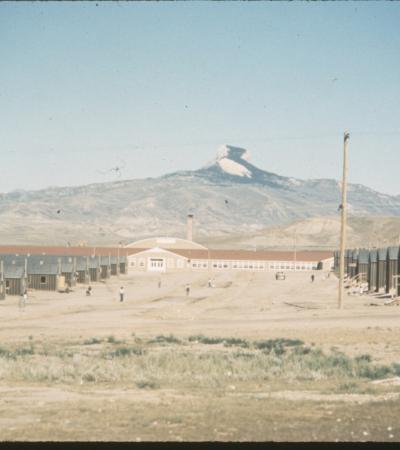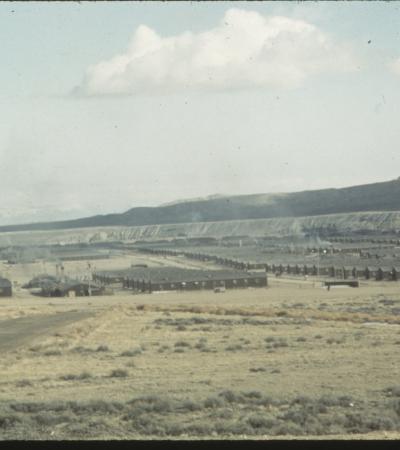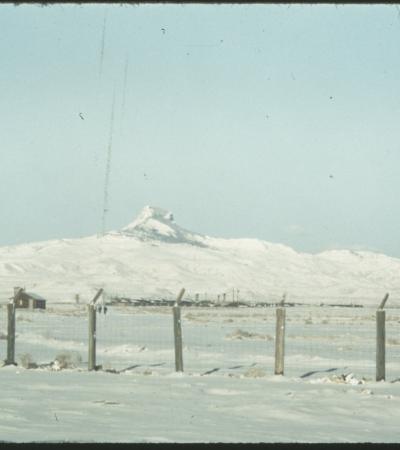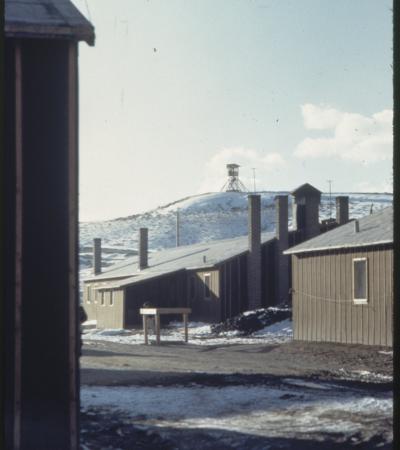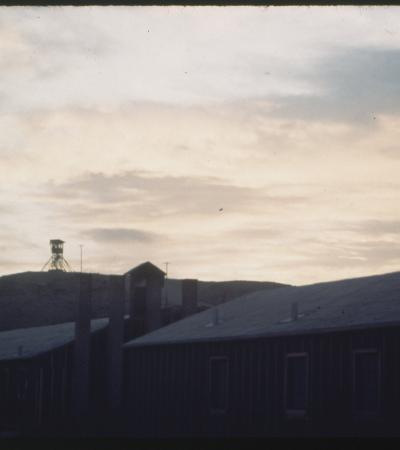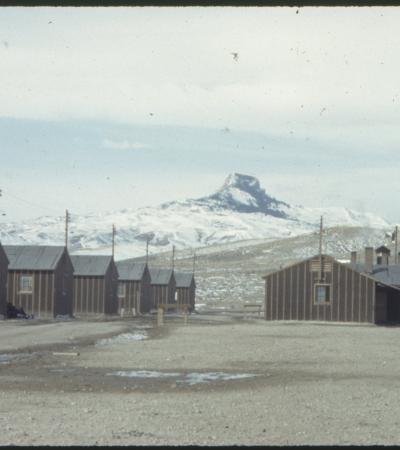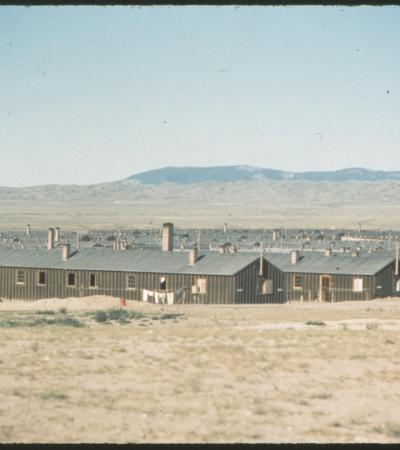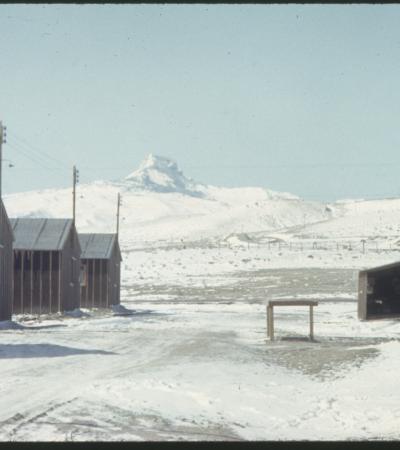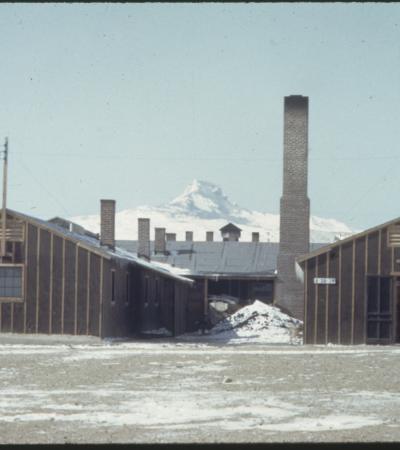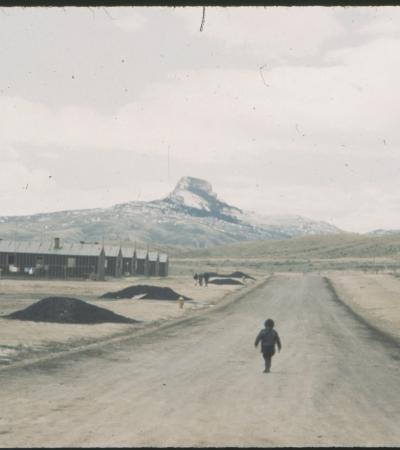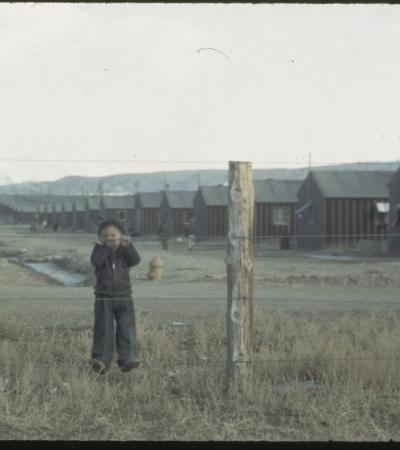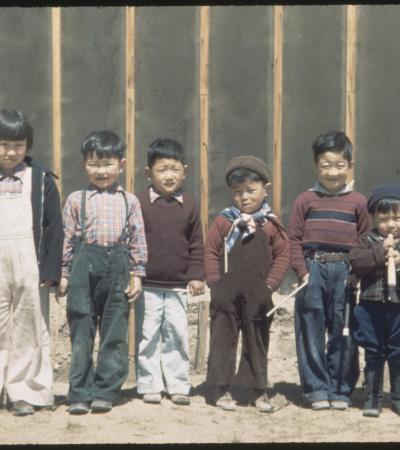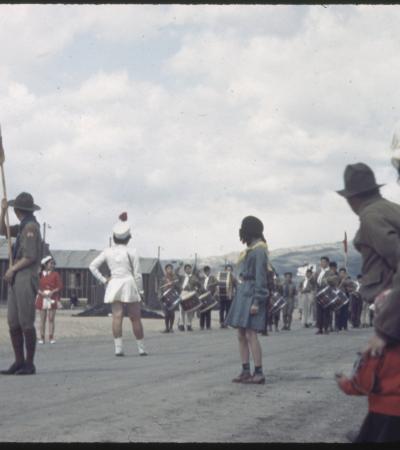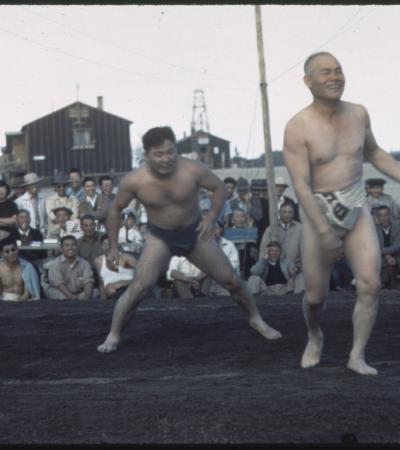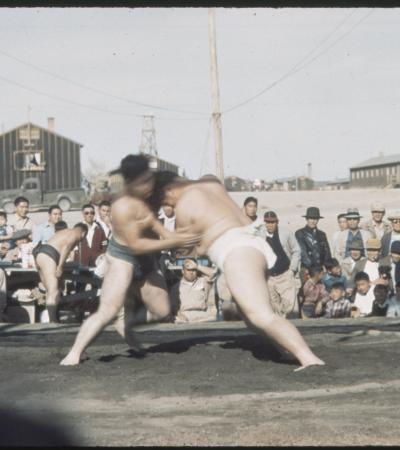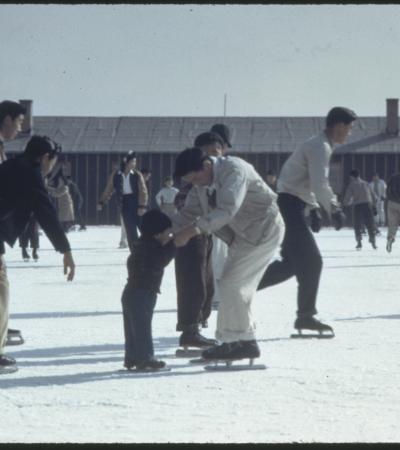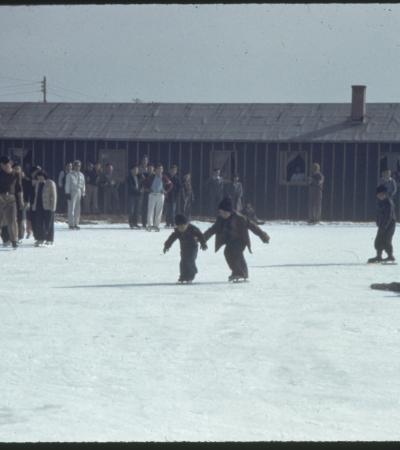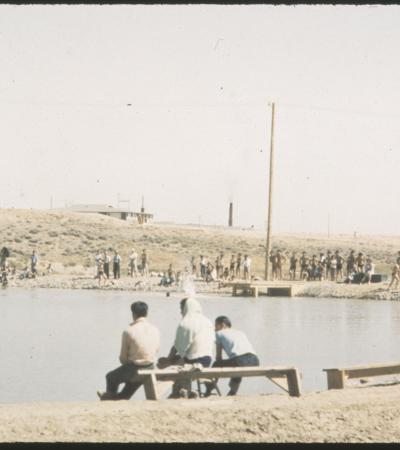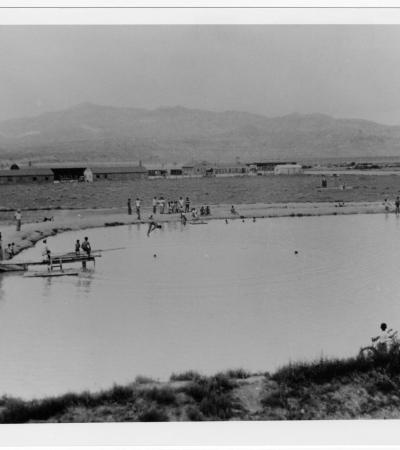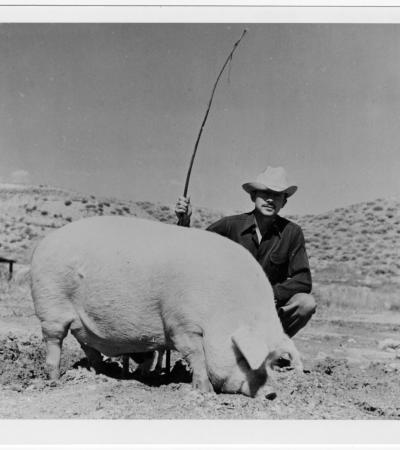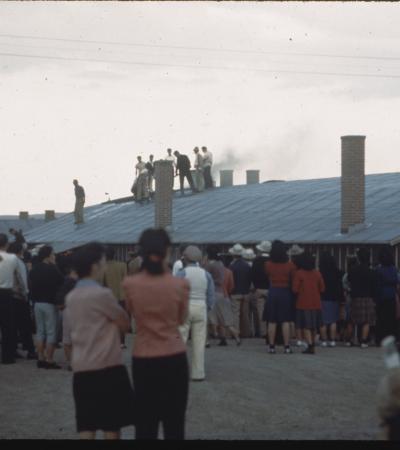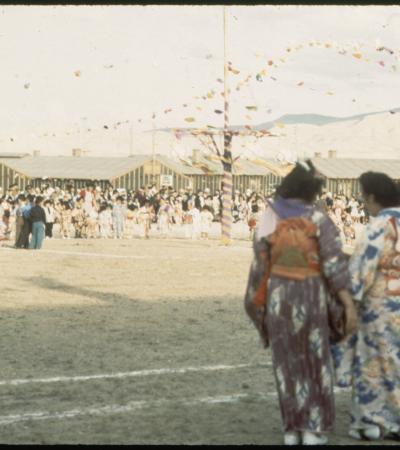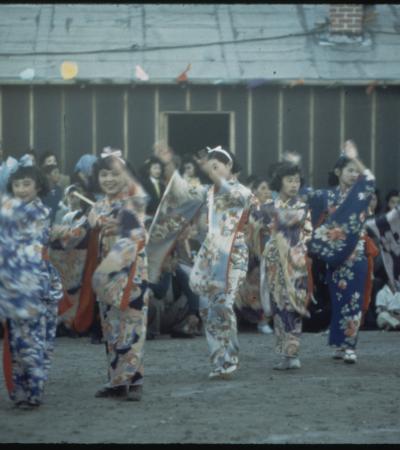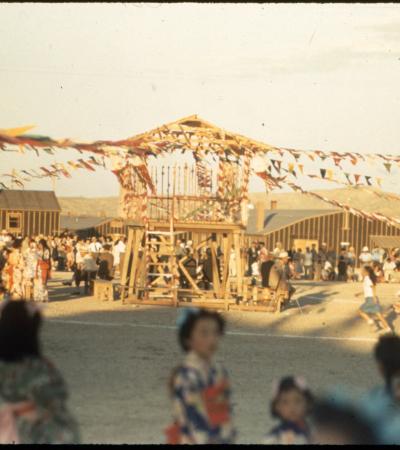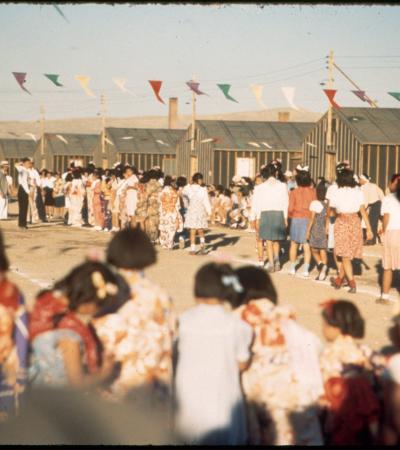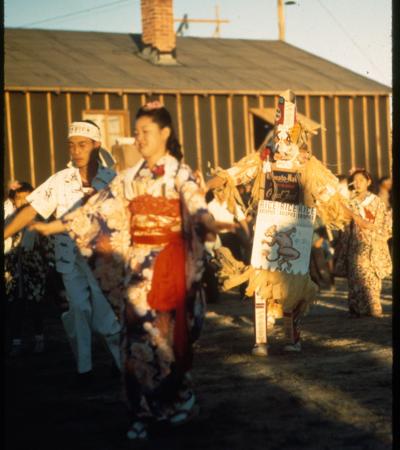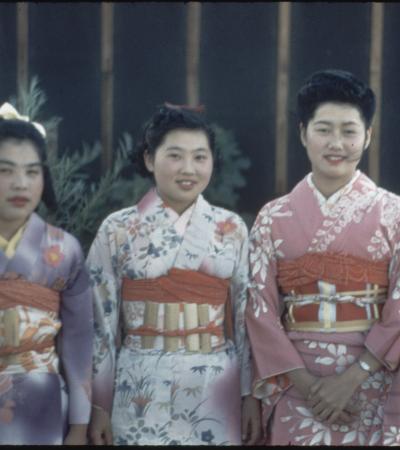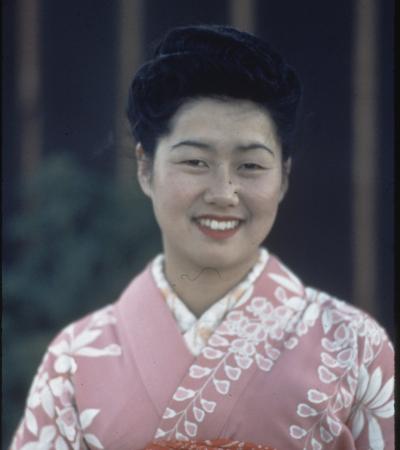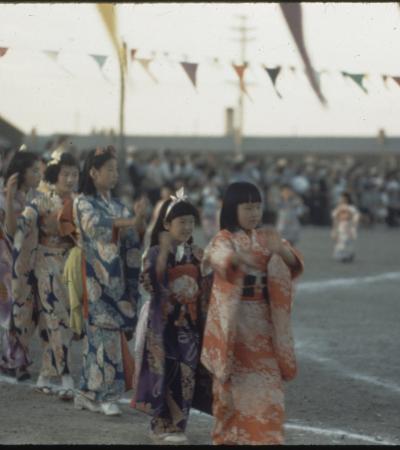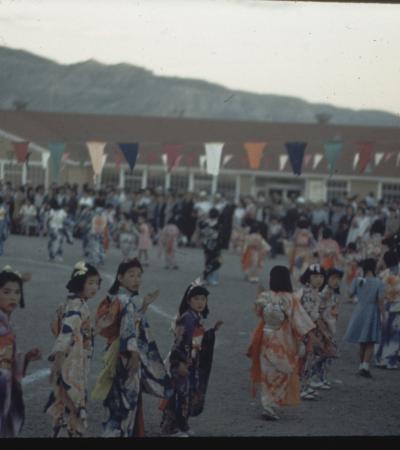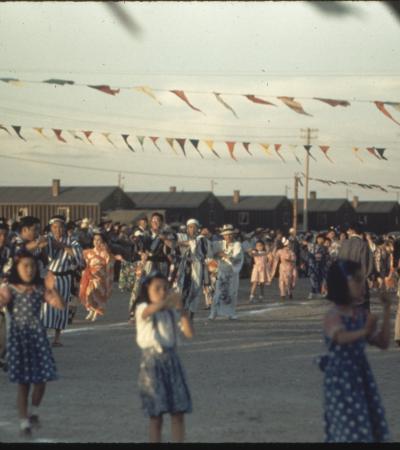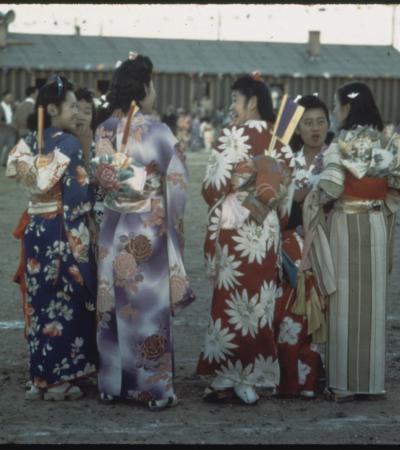Bill Manbo Sr. (1908-1992) was a Riverside, California native and a Heart Mountain internee. His parents were Japanese immigrations from Hiroshima. Bill, along with his wife and son, were forced to leave their home on April 28, 1942. They were sent to the Santa Anita Assembly Center before being interned at Heart Mountain. Manbo secretly documented life at Heart Mountain through photography, sending the film to Los Angeles for processing.
Additional content for this collection can be found in the "Inventory for collection."
View of Heart Mountain Relocation Center, ca. 1944
Incarcerees lived in barracks that were laid out in 20 blocks separated by unpaved roads. Each block held 24 barracks buildings, two mess halls, two buildings housing latrines and laundry facilities, and two recreation buildings.
Side view of Heart Mountain Relocation Center, ca. 1944
When plans were being prepared for the center, local town officials were adamant that they did not want the internees in their communities. The site for the center, halfway between the towns of Powell and Cody, was chosen for several reasons: because of its proximity to a water supply and to a railroad line that would provide the necessary transportation for tens of thousands of internees. But most important, the center's location was far enough from the two towns to satisfy those who insisted on keeping internees out.
Barbed wire surrounding Heart Mountain Relocation Center, ca. 1944. Heart Mountain seen in background.
In November 1942, administrators began erecting a barbed wire fence between the guard towers around the center. In protest, 3,000 incarcerees signed a petition aimed at WRA director Dillon Myer declaring that the fence was “an insult to any free human being, a barrier to a full understanding between the administration and the residents.” It made no difference, and the fence went up.
View of one of the nine guard towers at Heart Mountain Relocation Center, ca. 1944
The center was surrounded by barbed wire and patrolled by armed guard positioned in guard towers. The weapons of the guards were pointed into the camp.
Guard tower at Heart Mountain Relocation Center, ca. 1944
Nine guard towers with searchlights and armed gaurds surrounded the center. An internee caught outside the fence was arrested. On December 3, 1942, 32 people were arrested for sledding outside the fence. The oldest person arrested was 11 years old.
Structures at the Heart Mountain Relocation Center, ca. 1944
Barracks and hospital heating plant at Heart Mountain Relocation Center
Barracks and clothesline at Heart Mountain Relocation Center, ca. 1944
The center consisted of 467 barrack-style buildings sectioned into 20 blocks that served as administration areas and living quarters. The tarpaper barracks were divided into apartments, some single rooms and others slightly larger to accommodate families of up to six. Each unit was furnished only with a stove for heat, a light fixture in the center of the room, and an army cot and two blankets for each person. Each block had a mess hall, unpartitioned toilet, shower facilities, and a laundry area.
Barracks at Heart Mountain Relocation Center, ca. 1944. Heart Mountain in background.
After World War II, most of the land of the center was sold to former servicemen and hopeful farmers, many of whom benefited from the labor carried out by the internees. The residential barracks were sold or demolished and materials salvaged.
Restroom and laundry facilities at Heart Mountain Relocation Center, ca. 1944. Heart Mountain in background.
Bathrooms and laundry facilities were communal, differentiated by gender, and located in utility halls.
Coal piles outside barracks at Heart Mountain Relocation Center, ca. 1944
A fuel detail of internees at the Heart Mountain Relocation Center supplied coal for the stoves used to heat apartments.
Child climbing barbed wire fence enclosing Heart Mountain Relocation Center, ca. 1944
Young boy holding on to barbed wire fence with Heart Mountain Relocation Buildings in campus.
Group of child internees at Heart Mountain Relocation Center, ca. 1944
Six children pose in front of barracks building at Heart Mountain Relocation Center.
Boy Scout parade at Heart Mountain Relocation Center, ca. 1944
Parade at Heart Mountain Relocation Center with internees in Boy Scout troop.
Sumo wrestling at Heart Mountain Relocation Center, ca. 1944
Sumo wrestling with attendees at Heart Mountain Relocation Center.
Sumo wrestling at Heart Mountain Relocation Center, ca. 1944
At Heart Mountain Relocation Center, internees created self-made sumo wrestling pits to maintain a piece of Japanese culture amid the unfamiliar and bleak landscape.
Ice skating at Heart Mountain Relocation Center, ca. 1944
Internees ice skating on a pond constructed and flooded at Heart Mountain Relocation Center
Ice skating at Heart Mountain Relocation Center, ca. 1944
Ice skating and sledding were popular winter sports. A large area was flooded and allowed to freeze at the site of the high school creating the largest ice rink at Heart Mountain. Other small ice rinks existed within the residential blocks.
Swimming hole at Heart Mountain Relocation Center, ca. 1944
A giant pit near Heart Mountain Relocation Center's irrigation canal became a swimming hole and a favorite hangout.
Swimming hole at Heart Mountain Relocation Center, ca. 1944
A giant pit near the Center's irrigation canal became a swimming hole and a favorite hangout.
Hog at Heart Mountain Relocation Center, ca. 1944
Hogs were the center's "recyclers" feeding mostly on mess hall scraps.
Mess hall fire at Heart Mountain Relocation Center, ca. 1944
Fires were common because of the tar papered covered barracks.
Bon Odori Festival at Heart Mountain Relocation Center, July 15-16, 1944
Bon dances are a series of communal dances performed by men, women, and children alike while moving in a circle around musicians on a central platform called a yagura.
Bon Odori Festival, Heart Mountain Relocation Center, July 15-16, 1944
Traditional Japanese Bon Odori dance at Heart Mountain Relocation Center.
Bon Odori Festival, Heart Mountain Relocation Center, July 15-16, 1944
Stage at traditional Japanese Bon Odori Festival held at Heart Mountain Relocation Center.
Attendees organize a line at Bon Odori Festival at the Heart Mountain Relocation Center, July 15-16, 1944
About two-thirds of those incarcerated at Heart Mountain were Buddhist.
Closer look at the Bon Odori dance, July 15-16, 1944
Although the practice of Buddhism was initially discouraged by camp administrators, a Buddhist church was eventually established and such group events as Kabuki theater and Bon Odori were allowed.
Girls shown in traditional Japanese attire at Heart Mountain's Bon Odori Festival, July 15-16, 1944
A yukata is traditionally worn during Bon Odori festivals. The yukata is slipped on like a wrap dress or bath robe, and folded right under left. The obi (the sash used to hold up the yukata) is then wrapped around the waist 3 to 4 times and tied in a distinct bow worn on the back.
Young woman in traditional attire at the Bon Odori Festival, July 15-16, 1944
A yukata is traditionally worn during Bon Odori festivals. The yukata is slipped on like a wrap dress or bath robe, and folded right under left. The obi (the sash used to hold up the yukata) is then wrapped around the waist 3 to 4 times and tied in a distinct bow worn on the back.
Young women perform a traditional Bon Odori Festival dance at Heart Mountain Relocation Center, July 15-16, 1944
Each song, or ondo, performed during the Bon Odori Festival is accompanied by taiko drums.
Bon Odori dance, Heart Mountain Relocation Center, July 15-16, 1944
Each song, or ondo, performed during the Bon Odori Festival is accompanied by taiko drums.
Bon Odori dance, Heart Mountain Relocation Center, July 15-16, 1944
A Bon Odori festival typically lasts for three days.
Bon Odori Festival, Heart Mountain Relocation Center, July 15-16, 1944
Yukatas and happi coats are accessorized for the dances with flowers, towels, fans, or kachi-kachi (small wooden hand instruments).
